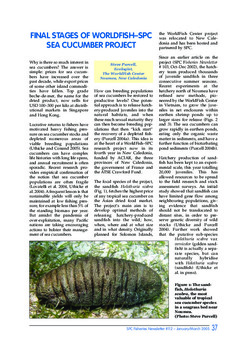Final stages of WorldFish-SPC sea cucumber project

Citation
Purcell, S.W. (2005). Final stages of WorldFish-SPC sea cucumber project. SPC Fisheries Newsletter, 112: 37-39
A joint WorldFish - Secretariat of the Pacific Community (SPC) project to restore to productive levels the breeding populations of sea cucumber, using the sandfish (Holothuria scabra) as the focal species, is in its final stage. Theproject's main aim is to develop optimal methods of releasing hatchery-produced sandfish into the wild; how, when, where, at what size, and in what density. One potential approach is to release hatchery-produced juveniles into the natural habitats, and when these reach sexual maturity they can become breeding populations used to initiate the recovery of a depleted fishery. The project hatcheries are at four sites along the main island of New Caledonia. The juveniles are grown in net enclosures within earthen shrimp ponds, where they can grow rapidly. A final experiment is underway with the goal of proving a proof of concept that sufficient numbers of sandfish can survive to maturity to make restocking a viable option. An initial 9000 juveniles were released into replicate sea pens (500m super(2)) at three different densities. The sea pens are simply a short plastic mesh fence, without cover, to limit the emigrationof the juveniles from the natural habitat but allow predators to reduce numbers as they would in a normal restocking situation without sea pens. Survival and growth of the juveniles will be monitored for 12 months.
Permalink
Date Available
Type
Countries
Topics
Language